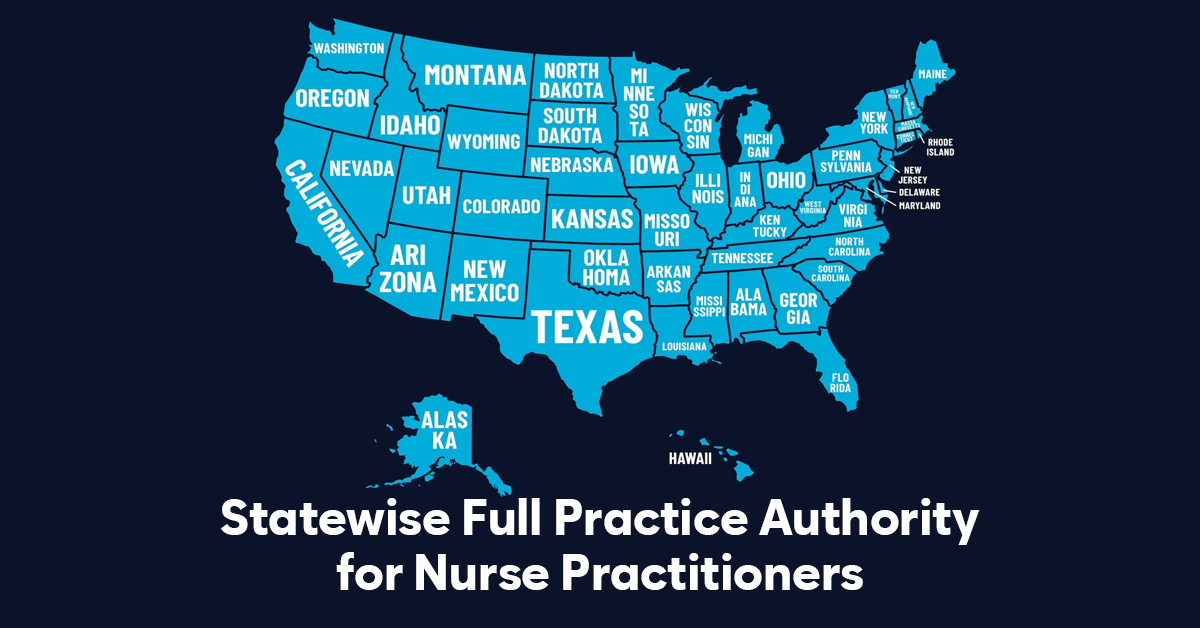In the intricate tapestry of the healthcare system, nurse practitioners (NPs) play a pivotal role in ensuring comprehensive and accessible patient care. However, the extent of their involvement varies across states due to differing regulations.
In this blog, we delve into the concept of practice authority for nurse practitioners. Also, exploring state-by-state variations in NP scope of practice and the impact on healthcare delivery. By identifying barriers and opportunities, we aim to shed light on empowering NPs to provide high-quality care and enhance nationwide patient access.
Understanding Full Practice Authority (FPA): A Key to Autonomy
Full practice authority (FPA) is a critical aspect that defines the extent to which nurse practitioners can exercise their skills and knowledge. According to the American Nurses Association (ANA), FPA allows NPs to practice to the full extent of their education, training, and competence. The American Association of Nurse Practitioners (AANP) refines this definition. Thereby, emphasizing that FPA encompasses the ability to evaluate patients, diagnose medical conditions, order and interpret diagnostic tests, manage treatments, and prescribe medications—all without the need for physician oversight or collaboration.
In states with FPA, nurse practitioners can operate independently, making clinical decisions that contribute to the delivery of primary and specialized healthcare services. This recognition of NPs’ unique expertise aims to maximize their impact on the healthcare system and improve access to high-quality care.
Navigating Nurse Practitioner Practice Authority
Practice authority for nurse practitioners is not a one-size-fits-all concept. There are three levels of practice authority: full, reduced, and restricted.
Full Practice Authority: NPs in states with full practice authority can diagnose, treat, prescribe medications, and manage patient care independently. Thus, eliminating the need for physician oversight or collaboration. This level of autonomy allows them to leverage their education and training to the fullest extent.
Reduced Practice Authority: States with reduced practice authority impose limitations on independent practice. Collaborative agreements or supervision by a physician may be required for certain activities, such as prescribing medications or ordering diagnostic tests.
Restricted Practice Authority: In areas with restricted practice authority, nurse practitioners face more significant limitations. They may be required to work under the direct supervision of a physician, restricting their autonomy and decision-making authority.
Mapping Nurse Practitioner Practice Authority Across States
The AANP’s Interactive State Practice Environment map provides a comprehensive overview of NP practice authority across states, Washington D.C., and U.S. territories. Let’s take a closer look at the breakdown:
Nurse Practitioner Full Practice Authority States: Alaska, Arizona, Colorado, Connecticut, Delaware, Guam, Hawaii, Idaho, Iowa, Kansas, Maine, Maryland, Massachusetts, Michigan, Minnesota, Montana, Nebraska, New Hampshire, New Mexico, New York, Nevada, North Dakota, Northern Mariana Islands, Rhode Island, South Dakota, Utah, Vermont, Washington, Washington D.C.
Nurse Practitioner Reduced Authority States: Alabama, American Samoa, Arkansas, Illinois, Indiana, Kentucky, Louisiana, Mississippi, New Jersey, Ohio, Pennsylvania, Puerto Rico, U.S. Virgin Islands, West Virginia, Wisconsin, Wyoming
Nurse Practitioner Restricted Authority States: California, Florida, Georgia, North Carolina, Oklahoma, South Carolina, Tennessee, Texas, Virginia
The Case for Full Practice Authority: Unleashing the Potential of Nurse Practitioners
Advocates of full practice authority for nurse practitioners highlight several compelling benefits:
Increased Access to Care: NPs in full-practice authority states are positioned to address the growing demand for primary care. Most importantly in rural and underserved areas. By removing restrictive regulations, NPs can independently deliver comprehensive healthcare services, bridging the gap in access to care.
Better Healthcare Efficiency: Full practice authority enables NPs to initiate and manage treatment plans more efficiently. Thus, reducing unnecessary delays in patient care. This autonomy contributes to improved patient outcomes, shorter wait times, and increased healthcare system efficiency.
Lower Healthcare Costs: Nurse practitioners with full practice authority often provide cost-effective care compared to physicians. Their increased autonomy allows for independent decision-making, leading to streamlined and cost-conscious healthcare delivery.
Patient Satisfaction: Research consistently demonstrates high patient satisfaction with care provided by NPs. The patient-centric approach, characterized by active listening and shared decision-making, is enhanced by FPA. Thus, aligning with a philosophy that results in higher patient satisfaction rates.
Conclusion
The state wise variation in nurse practitioner practice authority reflects a dynamic landscape in healthcare regulation. While proponents argue for the benefits of full practice authority, opponents cite concerns about patient safety and collaboration. As the healthcare system continues to evolve, finding a balance is important. There should be harmony between patient access, efficiency, and safety. As it is crucial in unleashing the full potential of nurse practitioners across the nation.






